
Quentin Matsys (1466–1530) was a Flemish painter in the Early Netherlandish tradition. He was born in Leuven. There is a tradition alleging that he was trained as an ironsmith before becoming a painter. Matsys was active in Antwerp for over 20 years, creating numerous works with religious roots and satirical tendencies. He is regarded as the founder of the Antwerp school of painting, which became the leading school of painting in Flanders in the 16th century. He introduced new techniques and motifs as well as moralising subjects without completely breaking with tradition.
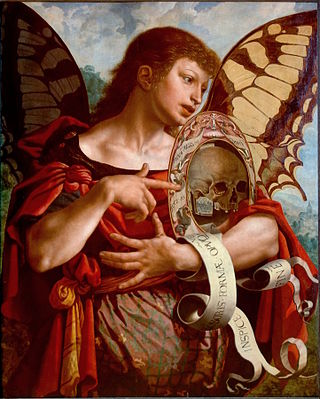
Jan Sanders van Hemessen was a leading Flemish Renaissance painter, belonging to the group of Italianizing Flemish painters called the Romanists, who were influenced by Italian Renaissance painting. Van Hemessen had visited Italy during the 1520s, and also Fontainebleau near Paris in the mid 1530s, where he was able to view the work of the colony of Italian artists known as the First School of Fontainebleau, who were working on the decorations for the Palace of Fontainebleau. Van Hemessen's works show his ability to interpret the Italian models into a new Flemish visual vocabulary.

Venus and Cupid with a Satyr is a painting by the Italian High Renaissance artist Antonio da Correggio. It is now in the Musée du Louvre in Paris.
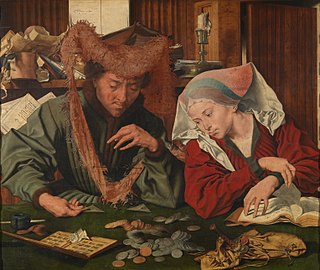
Marinus van Reymerswaele or Marinus van Reymerswale was a Dutch Renaissance painter mainly known for his genre scenes and religious compositions. After studying in Leuven and training and working as an artist in Antwerp, he returned later to work in his native Northern Netherlands. He operated a large workshop which produced many versions of mainly four themes: the tax collectors, the money changer and his wife, the calling of Saint Matthew and St. Jerome in his study.

The Royal Museum of Fine Arts Antwerp is a museum in Antwerp, Belgium, founded in 1810, that houses a collection of paintings, sculptures and drawings from the fourteenth to the twentieth centuries. This collection is representative of the artistic production and the taste of art enthusiasts in Antwerp, Belgium and the Northern and Southern Netherlands since the 15th century.

Joos van Cleve was a leading painter active in Antwerp from his arrival there around 1511 until his death in 1540 or 1541. Within Dutch and Flemish Renaissance painting, he combines the traditional techniques of Early Netherlandish painting with influences of more contemporary Renaissance painting styles.

Christ Crowned with Thorns is an oil on panel painting made in the 1530s by a follower of Hieronymus Bosch. It is now in the Monasterio de San Lorenzo at El Escorial, near Madrid, in Spain.

Tobias Verhaecht (1561–1631) was a painter from Antwerp in the Duchy of Brabant who primarily painted landscapes. His style was indebted to the mannerist world landscape developed by artists like Joachim Patinir and Pieter Bruegel the Elder. He was the first teacher of Pieter Paul Rubens.
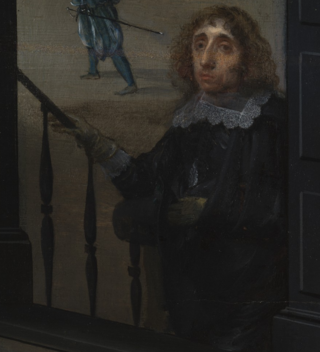
Willem van Haecht was a Flemish painter best known for his pictures of art galleries and collections.
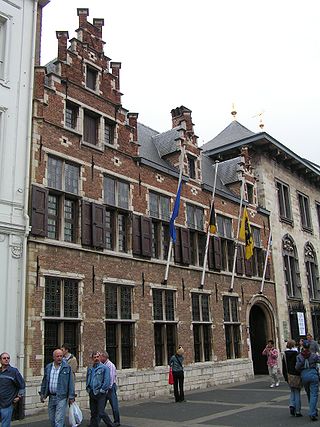
The Rubenshuis is the former home and workshop of Peter Paul Rubens (1577–1640) in Antwerp. Purchased in 1610, Rubens had the Flemish townhouse renovated and extended on the basis of designs by Rubens himself. After the renovations, the house and its courtyard garden had the outlook of an Italian palazzo, which reflected the artistic ideals of Rubens. The ensemble is now a museum dedicated mainly to the work of Rubens and his contemporaries.

Cornelis van Dalem was a Flemish painter and draughtsman active in Antwerp in the middle of the 16th century and an important contributor to the development of landscape art in the Low Countries. Van Dalem introduced into landscape painting new themes, which he derived from his humanistic education, and searched for new ways of representing his themes.

Venus Blindfolding Cupid is a c.1565 painting by Titian, now in the Galleria Borghese in Rome.

Cornelis van der Geest was a spice merchant from Antwerp, who used his wealth to support the Antwerp artists and to establish his art collection. He was also the dean of the haberdashers guild.
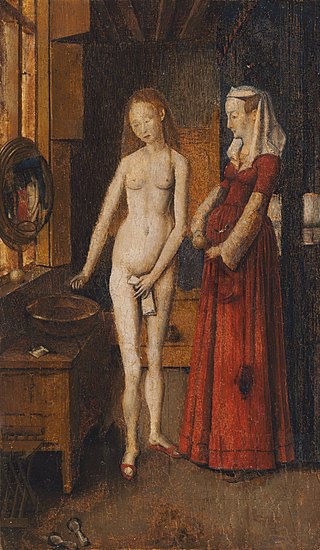
Woman Bathing is a lost panel painting by the Early Netherlandish artist Jan van Eyck. The work is today known through two copies which diverge in important aspects; one in Antwerp and a more successful but small c 1500 panel in Harvard University's Fogg Museum, which is in poor condition. It is unique in van Eyck's known oeuvre for portraying a nude in secular setting, although there is mention in two 17th-century literary sources of other now lost but equally erotic van Eyck panels.

The Battle of the Amazons or Amazonomachia is an oil on wood painting produced around 1615. It shows an amazonomachy. It is usually attributed to Rubens, showing his huge admiration for Leonardo da Vinci and his The Battle of Anghiari, though the biographer Giovanni Pietro Bellori has attributed it to Anthony van Dyck. It is now in the Alte Pinakothek in Munich.

Portrait of a Commander or A Commander Being Dressed for Battle is a portrait of an unknown man in plate armour, by Peter Paul Rubens. In July 2010 it was sold for £9 million by Christie's after Sotheby's turned it down, suspecting its authenticity as a Rubens. In December 2011, the portrait was placed on loan with the Metropolitan Museum of Art in New York.
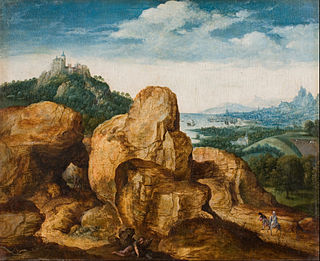
Cornelis Massijs, was a Flemish Renaissance painter, draughtsman and engraver, mainly known for his landscapes and, to a lesser extent, genre scenes and portraits. He is regarded as an important figure in the transition from the fantastic landscapes of Joachim Patinir to the 'pure landscapes' of later Netherlandish landscape painting.

The Reconciliation of Esau and Jacob is a 1624 painting by Peter Paul Rubens. Originally in the Spanish royal collection, it was sent to Germany by Maria Anna of Neuburg to her brother Johann Wilhelm. It is now in the Staatsgalerie Schleissheim near Munich.

Samson and Delilah is a 1630 painting by Anthony van Dyck. Like his 1620 version of the subject, it is in the style of his former master Peter Paul Rubens. Unlike Rubens, however, van Dyck shows Delilah seemingly appalled at her own betrayal of Samson and regretting her act of treason, whereas Rubens showed him as a captive and her as an unscrupulous temptress. Van Dyck's palette in the work also reveals the influence of Titian during van Dyck's stay in Italy. It is now in the Kunsthistorisches Museum in Vienna.

Madonna and Child Kissing is a 1520s oil on panel painting by the Flemish renaissance artist Quentin Matsys in the collection of the Rijksmuseum, Amsterdam, on loan to the Mauritshuis.






















